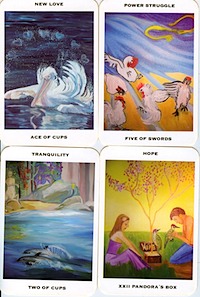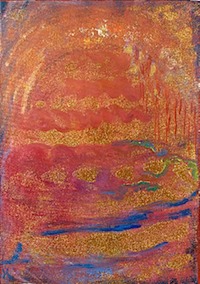By Sheri Harshberger
Only good things can happen when a fine artist takes on the task of creating a Tarot deck. This case is no exception. Hedy Maimann, a gifted fine artist, who, and I'm no expert, seems to be specialized in impressionist and abstract art, has created a stunning and ethereal deck for the global Tarot community.
Hedy's deck, Tarot of Inner Peace, is a 79-card Tarot deck, comprised of the traditional 78-cards plus an additional card called “Pandora's Box.” The image on each card is representative of an oil on canvas painting done by Hedy to transcend the darkness and heaviness associated with the traditional, older Tarot decks.
The deck comes packaged in a black box with the image of two dolphins from the Two of Cups card. The box is attractive and lettered in gold, but it is constructed from a lighter weight cardboard – which seems to be the trend in boxing lately – so it won't stand up to much abuse. I immediately moved the deck to a bag and put the box away. Hedy includes a double-sided title card and a sheet of meanings to cover the purpose of a little white book (LWB). I tend to forgive some of these cost-cutting measures, especially when the decks are self-published and the money is going for the cards themselves.
The cards are somewhat shorter and wider than a traditional Tarot deck at a little more than 3 inches wide and a little more than 4 and ½ inches tall. The image of each card is featured prominently and is well sized for the card. The image is bordered on all sides by a white border that is thicker at the top and bottom than it is on the sides. The card title is centered within the bottom border and a key phrase is centered within the top. The Major Arcana in the deck are numbered, with the number of the card included with the title in the border. The Fool is numbered as 0, Strength is 8 and Justice is 11. The additional card, Pandora's Box, is numbered 22 and carries the key phrase “Hope.” Although I don't use them here, Roman numerals are used for the numbering of the Majors. Numbers are spelled out in the Minors. The backs of the cards are mostly blue with thin gold border. The image is of the Earth with a faint spiral surrounding it and rising above it into the blue surrounding it. Movement is depicted around it with bold brush strokes. The deck is not reversible and no reversed meanings are given. The cards are a bit sticky at first, but as they are used, they become easier and easier to work with.
The traditional Wands, Swords, Cups and Coins are used in the titles of the cards of the Minors, with each representing fire, air, water and earth respectively. Interestingly, Hedy uses other things to represent the suits in the images she uses. For Wands, she uses unicorns. Swords are birds. Cups, as the water element, are depicted as cups, swans, and other water creatures. Coins as earth are represented by golden flower coins and elephants.
The images are stunning. They remind me of a dream state. There is just enough there to be recognizable, but I am still able to fill in the details with my mind... so it is easy for me to insert myself or others I know into the cards. Many of the images provided new insight into the traditional meanings of the cards as I understand them. My favorite card in deck is the Two of Wands, which depicts two trees with a branch from each arching over a pathway, seemingly becoming one, and bears the key phrase “Have Faith.” Wow. The Five of Swords is shown as five chickens fighting with the phrase “Power Struggle.” The Ace of Cups is also a favorite because it is so stunningly beautiful. It shows a white pelican on dark water shaking its feathers as it settles. Some of the spray forms tiny hearts in an arch over its head.
The double-sided title card gives instructions on the use of the Inner Peace Spread, which is a 6-card layout meant to assist the reader and/or sitter with finding resolution to an issue that is plaguing them. It is really very therapeutic when used. I found some of the answers I was getting a bit uncomfortable – because they were spot on! The sheet of meanings is tri-folded to provide 6 pages of meanings from the Majors through the Minors. The card and sheet together provide as much information as many small bound LWBs with other decks do.
Many Tarot traditionalists will most likely label this deck too “new agey” and not give it another look. While fully capable of giving dark readings, this deck is more focused on the positive and on positive ways of dealing with the issues that come up. I personally found this deck more suited for readings for myself, not because of it, but because of its effect on me. I found I was journeying inward much more with this deck than I do with any of my other decks. I recommend it to readers that like positive affirmation decks as well as collectors that like this type of artwork.

